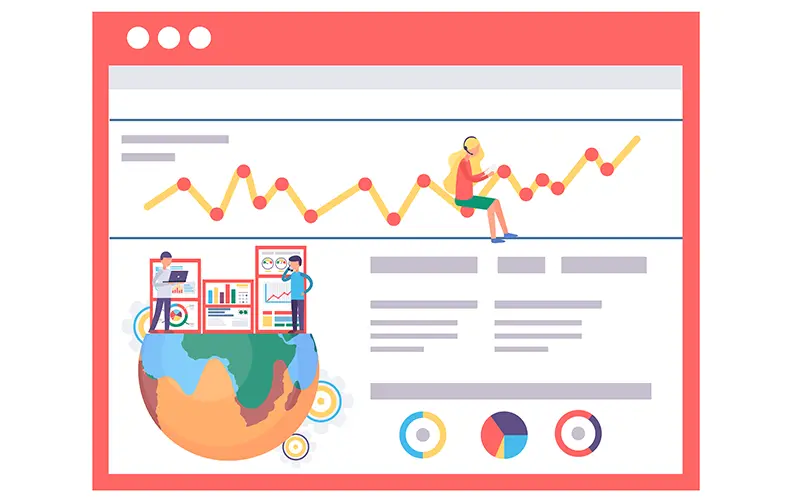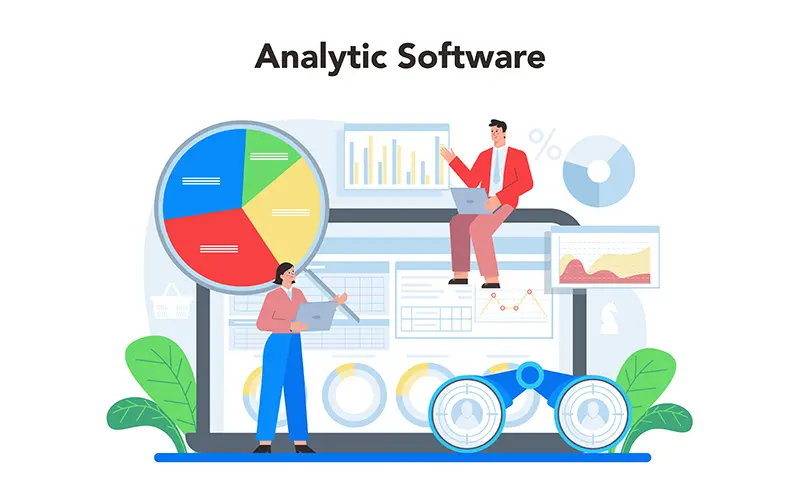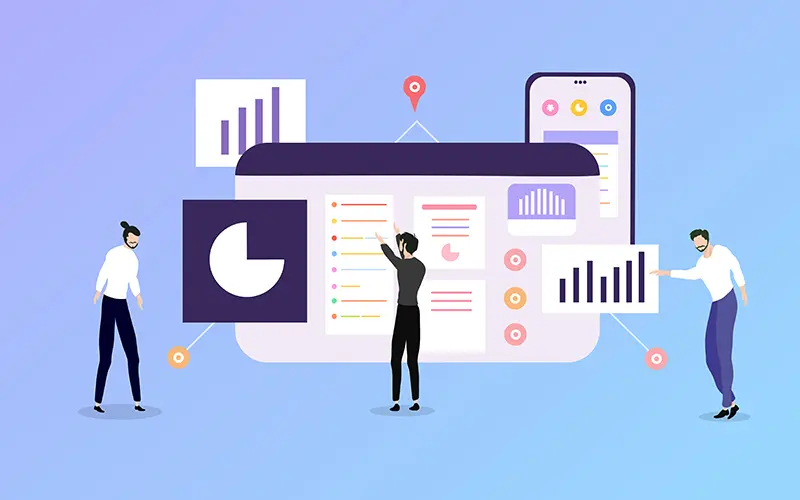In today's digital age, having a strong online presence is crucial for any business or individual. But simply having a website isn't enough.
To maximize your online presence, it's essential to analyze your website visitor statistics and how you acquire customers. By understanding who visits your site, how they find you, and what actions they take, you can make data-driven decisions to optimize your online strategy.
In this article, we'll learn about the importance of website statistics, explore different ways to track and analyze your website visitors, and discuss how to check your funnel for a smooth user experience. Whether you're a business owner or a digital marketer, this guide will provide you with valuable insights to help you make the most of your online presence.
1. The importance of analyzing website visitor statistics

Analyzing your website visitor statistics is crucial to understanding your online audience and improving your online presence. By analyzing your data, you can gain insights into who is visiting your website, where they are coming from, and what actions they are taking. With this information, you can make data-driven decisions to optimize your website and marketing strategy.
- First, analyzing your website visitor statistics can help you understand the demographics of your audience. By knowing the age, gender, location, and interests of your visitors, you can tailor your content and marketing efforts to their needs and preferences. This can help you increase engagement and conversion rates on your website.
- Second, tracking how visitors find your website is essential for optimizing your customer acquisition methods. By analyzing referral sources such as search engines, social media platforms, or in-person visits, you can determine which channels drive the most traffic and allocate resources accordingly.
- Third, understanding the behavior of your website visitors can help you identify areas for improvement and enhance the user experience. By tracking metrics like bounce rate, time on site, and conversion rate, you can identify bottlenecks in your funnel and make the necessary adjustments to increase conversion rates and overall engagement.
In conclusion, analyzing your website visitor statistics is a powerful tool for maximizing your online presence. It provides valuable insights into your audience, how they acquire customers, and their user experience. With this data, you can make informed decisions to optimize your website and marketing strategy, ultimately increasing visibility, engagement, and conversions.
2. Understand the different sources of your website traffic
Understanding the different sources of your website traffic is another important aspect of maximizing your online presence. By knowing where your website traffic is coming from, you can focus your efforts on the most effective channels and optimize your customer acquisition strategy.
There are a few common sources of website traffic. One of the main sources is organic search, which means traffic from search engines like Google. By optimizing your website for relevant keywords and improving your search engine rankings, you can attract a steady stream of organic traffic.
Another important source is social media. Platforms like Facebook, Instagram, and Twitter can drive a significant amount of traffic to your website when utilized strategically. By creating engaging content, building a strong online presence, and utilizing targeted ads, you can reach a wider audience and increase the number of visitors to your website.
Paid advertising is also a valuable source of traffic. By investing in platforms like Google Ads or social media ads, you can drive targeted traffic to your website. This method allows you to reach specific demographics and measure the effectiveness of your ad campaigns.
Referral traffic also plays an important role in driving visitors to your website. This includes traffic from other websites, blog posts, or online directories that link back to your site. You can increase the number of referral visitors by building relationships with relevant websites and creating high-quality content that others want to share.
In conclusion, understanding the different sources of your website's traffic is essential to maximizing your online presence. By knowing which channels drive the most traffic, you can effectively allocate your resources and optimize your customer acquisition strategy. Whether it's organic search, social media, paid advertising, or referral traffic, each source offers unique benefits that can contribute to the overall success of your website and online presence.
3. Utilize analytics tools to track and measure website performance

Utilizing analytics tools to track and measure your website performance is critical to maximizing your online presence. Once you've identified the various sources of your website traffic, it's important to gain a deeper understanding of your visitors' behavior and interactions on your website.
Analytics tools like Google Analytics can provide valuable insights into your website's performance. It allows you to track visitor statistics such as number of visitors, geographic location, pages visited, and more. By analyzing this data, you can better understand your target audience and tailor your content and marketing strategy accordingly.
Analytics tools also allow you to measure the effectiveness of your customer acquisition strategies. You can track conversion rates, bounce rates, and other key metrics to understand which channels are driving the most valuable traffic to your website. Armed with this information, you can make data-driven decisions to optimize your customer acquisition strategy and allocate resources effectively.
In addition to Google Analytics, you can use URL shorteners to convert long URLs into shorter ones. Link shorteners are a simple way to get insights into the number of visitors, where they came from, their geographic location, and the platform, browser, and device they're using, without the extensive learning curve of Google Analytics.
You can list different shortened links for each of your social platforms (Instagram, YouTube, Facebook, Twitter, etc.), analyze the data, and then make smart decisions about where and how to invest your marketing resources.
In conclusion, utilizing analytics tools is essential to maximizing your online presence. By measuring and analyzing your website's performance, you can gain valuable insights that can guide your marketing efforts and help you achieve your business goals. Stay tuned for the next section, where we'll discuss the importance of optimizing your website to improve user experience and increase conversion rates.
4. Strategies to improve website acquisition
To maximize your online presence, it's important to continually improve your website acquisition strategy. By increasing the number of visitors to your website, you can expand your reach and increase your chances of converting them into customers.
One effective strategy is to optimize your search engine optimization (SEO) efforts, which includes incorporating relevant keywords into your website content, meta tags, and URLs to improve your search engine rankings. By appearing higher in search engine results, you can drive more organic traffic to your website.
Another strategy is to utilize social media platforms. By creating engaging and shareable content, you can encourage your followers to share it with their networks. This can increase your visibility and drive traffic back to your website.
Also, consider investing in paid advertising campaigns like Google Ads or social media ads. These platforms allow you to target specific demographics and reach a wider audience.
By implementing these strategies, you can effectively increase the number of visitors to your website and increase your online presence. In the next section, we'll explore the importance of optimizing your website to improve user experience and drive conversions - stay tuned!
5. Analyze visitor behavior and engagement metrics

Analyzing visitor behavior and engagement metrics is a critical step in maximizing your online presence. By understanding how visitors interact with your website, you can identify areas for improvement and optimize the user experience.
One of the key metrics to track is your bounce rate (the percentage of visitors who leave your site after viewing only one page). A high bounce rate could mean that your website isn't engaging or relevant enough to retain visitors. By analyzing your bounce rate and identifying the pages with the highest bounce rate, you can make the necessary changes to improve engagement.
Another important metric is average session duration, which is the amount of time a visitor spends on your website. A high average session time means that visitors are finding value and engaging with your content. By analyzing this metric, you can determine which pages or content elements are driving engagement and replicate that success across your site.
It's also essential to track your conversion rate. A conversion can be a purchase, a form submission, or any other behavior you want. By analyzing your conversion rates, you can determine which channels or campaigns are driving the most conversions and optimize your customer acquisition strategy accordingly.
In the next section, we'll take a closer look at the importance of website security and how it can boost your online presence. Stay tuned for insightful tips for keeping your website safe and building trust with your visitors.
6. Integrate data-driven insights into your online marketing strategy
Incorporating data-driven insights into your online marketing strategy is a key factor in maximizing your online presence. The metrics mentioned in the previous section, such as bounce rate, average session duration, and conversion rate, provide important information to help you make decisions.
Analyzing these metrics gives you insight into visitor behavior and preferences, so you can tailor your marketing efforts to effectively engage your target audience. For example, if you notice that certain pages have a high bounce rate, you can investigate why visitors are leaving and make the necessary improvements to increase engagement.
Similarly, if you know which content or campaigns drive the most conversions, you can allocate resources to the most effective strategies. This data-driven approach not only helps you optimize your customer acquisition efforts, but also allows you to effectively allocate your marketing budget.
You can also compare the number of clicks on short links created with a URL shortener, and if your links are getting fewer clicks, it means that your content is doing less to engage users, so you can beef up your content to match current trends.
7.
In conclusion, analyzing your website visitor statistics and customer acquisition data is essential to maximizing your online presence. The aforementioned metrics provide valuable insights into visitor behavior and preferences, allowing you to effectively tailor your marketing efforts. By addressing high bounce rates and optimizing conversions, you can make the necessary improvements to engage your target audience and allocate resources to the most effective strategies.
In today's digital landscape, it's critical to provide a seamless user experience across devices.
Thank you.



